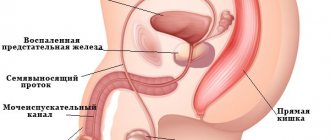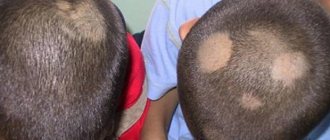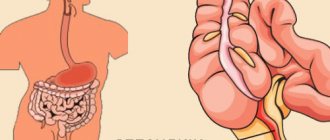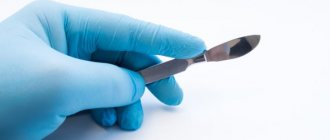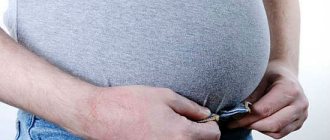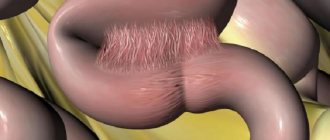Kinds
The abdominal wall consists of muscles located mirror-image on either side of the midline. These are the rectus abdominal muscles, as well as the transverse, internal and external obliques. They are connected in the middle by a tendon formation - a membrane, or linea alba, the weakening of which leads to diastasis (divergence) of muscle groups and the formation of a hernia. In this tendon formation there are openings in the form of slits through which nerve and vascular bundles penetrate. This is where hernia formations most often occur, usually in the upper third, less often near the navel or in the lower abdomen.
Based on the location of the hernial sac, the following hernial formations are distinguished:
- epigastric;
- umbilical;
- incisional;
- Spiegel's hernia.
An epigastric hernia occurs most often in infants when the upper midline is weakened. At this point, both rectus muscles connect to the lower part of the sternum - the xiphoid process. Sometimes such a hernial formation develops in adulthood and manifests itself as a protrusion in the upper part of the abdominal wall.
Umbilical hernia in an adult
The navel is the exit point of the umbilical cord, which connects the fetus and the maternal body during intrauterine development. After the birth of the child, the umbilical cord disappears, but the hernial sac remains possible in this place. A hernia in this area is accompanied by protrusion of the navel. It is common in infants and often does not require treatment. The need for surgery arises only when unfavorable signs appear. In the future, surgical treatment is carried out when the size of the hernia increases.
There are several types of umbilical hernia formations:
- embryonic;
- occurred in a child;
- first formed in an adult.
The embryonic form is referred to as developmental anomalies that occur when the formation of the abdominal cavity of the embryo is disrupted. Its outer wall includes the umbilical cord amniotic membrane and an underdeveloped layer of peritoneum.
In children, an umbilical hernia occurs as a result of improper development of the abdominal muscles. It most often occurs in infants in the first months of life, mainly in girls. Under the influence of increased intra-abdominal pressure (constant crying, constipation, bloating), the ring around the navel expands, and part of the intestine protrudes there. Such hernias are usually small.
In adulthood, such formations account for up to 5% of hernias. They appear in people over 50 years of age, much more often in women, after multiple births and against a background of obesity. Often, sagging of the abdomen occurs simultaneously due to weakness of the abdominal muscles.
An incisional or postoperative hernia occurs as a result of surgery on the abdominal organs if the doctor did not connect the tissues well enough after the incision. However, even with good tissue suturing, the incision site becomes weaker than the nearest muscles and can potentially become an opening for hernial contents. After laparotomy, hernia formations appear in a third of patients. Their causes may be inflammation of the postoperative wound, drainage of the abdominal cavity and prolonged use of tamponade.
Spiegel's hernia is a rare formation that occurs at the edge of the anterior abdominal muscle.
Varieties
Classification of hernias by location:
- Inguinal. Oblique - the hernial sac is pressed through the outer ring of the inguinal canal. It contains the spermatic cord. With further progression, the intestinal loop descends into the scrotum - a giant hernia, popularly called clubroot, can form there. Direct - a protrusion forms in the area of the internal ring on the anterior abdominal wall - the hernia is squeezed out through the inguinal canal without getting inside it.
- Linea alba. Subcutaneous fatty tissue and the lower edge of the omentum protrude through the aponeurosis of the midline of the abdominal cavity. The protrusions are located on the tendon strip: from the chest to the pubic tubercle.
- Umbilical Hernial formations extend beyond the boundaries of the umbilical ring. The navel of a woman or baby is most often affected.
Forms
Depending on the time of appearance, abdominal hernia can be congenital or acquired. The congenital form is observed immediately after the birth of the child, the acquired form appears over time in a weakened area of the abdominal wall. The cause of this disease is high pressure inside the abdominal cavity.
High intra-abdominal pressure occurs in the following cases:
- persistent cough, for example, due to lung diseases;
- the formation of excess fluid in the abdominal cavity (ascites) as a result of a tumor, heart, liver or kidney failure;
- a peritoneal dialysis procedure, which is used to treat kidney failure and tumors of internal organs;
- rapid weight loss;
- chronic constipation or constant difficulty urinating;
- abdominal trauma;
- pregnancy;
- obesity.
Reducible hernia: a - under the skin, b, c - reduction together with the hernial sac
All of these conditions increase the risk of acquired abdominal hernia. There is a hereditary predisposition to this disease.
Forms of abdominal hernia:
- reducible: looks like a “bump” on the skin, painless when pressed, increases in size in an upright position, can be reduced into the abdominal cavity;
- unreducible: it is not possible to place the contents of the protrusion inside, or it is accompanied by pain.
A complicated form of hernia is strangulated. It is accompanied by penetration of part of the intestine beyond the abdominal wall and compression of the blood vessels of the intestine. As a result, tissues die and are destroyed, which leads to pain, intoxication, intestinal obstruction and peritonitis. Incarceration complicates the course of the disease in 20% of patients.
Other complications of the disease:
- inflammation;
- fecal retention - coprostasis;
- damage (trauma);
- malignant neoplasm of the intestine.
Symptoms
The main sign of a hernia is a rounded protrusion with a dough-like consistency, which is reduced when pressed while lying down.
Symptoms depend on the size of the hernial sac. If there is an intestinal loop in it, then rumbling caused by peristalsis is often heard.
A specific symptom will be a “cough impulse”. When the patient coughs, a shock is felt on the surface of the protrusion. This confirms the connection with the abdominal cavity. If such a symptom is absent, then strangulation of the hernial sac is suspected.
When the pathology is large, the patient begins to experience unpleasant dyspeptic disorders (nausea, constipation, heartburn, belching, bloating) and problems with urination.
It is important to recognize the signs of a strangulated hernia:
- intense pain in the area of the protrusion;
- the formation cannot be straightened, it has become hard;
- vomiting, fever, constipation.
Important!
When pinched, the blood supply to the tissues stops, which leads to their death. Immediate surgical intervention is required; the damaged organ is removed completely or partially. In the absence of qualified help, a person dies.
The main complications include:
- complete or marginal strangulation with tissue necrosis and peritonitis;
- impaired intestinal patency;
- phlegmon - suppuration;
- enlargement of the hernia.
The essence of the technique
Reviews after the article
Meirama pillow
We accept pre-orders.
Order
Signs
The first manifestation of an abdominal hernia is a rounded protrusion under the skin of the abdominal wall. It is soft, painless and initially can be easily reduced when pressed with the palm of your hand. Sometimes there is a feeling of fullness and discomfort at the base of the hernia. When lifting heavy objects, short-term sharp pain sometimes occurs. With a temporary increase in pressure in the abdominal cavity, for example, during defecation or coughing, the formation increases. The pain becomes worse after eating or exercising, and constipation often occurs.
If a portion of the intestine or omentum gets into the hernial protrusion, signs of complications may occur. The organ is pinched at the site of the hernia. The blood vessels feeding it are compressed. This is possible with a sharp increase in pressure in the abdominal cavity. Severe pain occurs in the hernia area, the patient experiences nausea, and often vomiting - signs of intoxication. Intestinal obstruction develops. It is accompanied by bloating, lack of stool and gas. Body temperature rises.
Sudden sharp pain in the upper abdomen is one of the first symptoms of an abdominal hernia.
If a patient with such a complication is not operated on in time, the hernial contents will necrotize and peritonitis will develop, a serious life-threatening condition.
In some patients, only part of the intestinal wall is pinched. In this case, there are no symptoms of intestinal obstruction, the protrusion on the abdomen does not increase, but the person is worried about increasing pain and signs of intoxication.
The peculiarity of an umbilical hernia is a narrow gate, with a diameter of no more than 10 cm. However, the size of the formation itself can be very large. The risk of strangulation, fecal stagnation, and chronic intestinal obstruction increases.
In the initial stages of a hernia of the white line, when only fatty tissue penetrates through its cracks, the first symptom of the disease is a sudden sharp pain in the upper abdomen, reminiscent of an attack of cholecystitis or peptic ulcer.
Possible complications
A hernia must be recognized and treated promptly. The consequence of the wait-and-see method may be:
- Rupture of the hernial sac.
- Strangulated hernia.
- Stagnation of feces.
- Development of inflammation.
Strangulation is considered a common complication of a hernia. This condition is often recorded in older people. The main symptoms of the pathology are acute pain in the abdomen or in the area of protrusion, the inability to reduce, and the absence of a cough impulse.
There are several types of infringement:
- Obstructive. It is dangerous to stop stool due to intestinal kinks.
- Regional. A small part of the intestinal wall is pinched. If untreated, perforation and necrosis are detected in this area.
- Strangulation. It is dangerous due to the development of intestinal necrosis due to compression of the mesenteric vessels.
The main symptoms of the pathology are acute pain in the abdomen or in the area of protrusion.
Treatment of abdominal hernia
A protrusion that appears on the front wall of the abdomen is a reason to contact a surgeon. Part of the intestine lying in the hernial sac may suddenly become strangulated, requiring complex emergency surgery. You should immediately consult a doctor in cases of pain, sudden increase in protrusion, impossibility of reduction, fever, nausea and vomiting.
Abdominal hernias are removed surgically. At the same time, the integrity of the abdominal muscles is restored. Synthetic materials are often used for this purpose, reliably covering the defect. The purpose of this treatment is to prevent strangulation of the hernia and the development of dangerous complications.
If the hernia is small, surgical treatment is not required. In addition, the operation is not performed if there is a high risk of complications in weakened and elderly patients, as well as in patients with severe concomitant diseases - severe rhythm disturbances, severe cardiac or respiratory failure, malignant hypertension or decompensated diabetes mellitus. Contraindications also include malignant tumors, acute infectious diseases, exacerbation of inflammatory processes (pyelonephritis, bronchitis, tonsillitis, etc.), pustular skin diseases.
Relative contraindications for which surgery is still possible include:
- pregnancy;
- concomitant diseases in the stage of compensation and subcompensation (for example, stable angina, hypertension with a moderate increase in pressure, diabetes mellitus with normal levels of sugar and glycated hemoglobin);
- BPH.
Such patients are offered conservative treatment methods: bandages and corsets. They are considered only a temporary way to prevent complications and can potentially cause skin infections due to constant friction. The bandage can only be used for a reducible hernia. Its constant use weakens the abdominal muscles and leads to the progression of the disease.
In 99% of children with an umbilical hernia, it does not exceed 1.5 cm in diameter and disappears as the child grows. Surgery for umbilical hernia in children is performed at 3–4 years of age, if by that time the defect has not disappeared. If the hernia is large, surgical intervention is performed starting from the child’s 1st year of life. With a small size of the formation, self-healing is possible at the age of 3–6 years. However, the operation must be performed or completely abandoned before the child enters school. After this, the elasticity of the tissue begins to decrease, the hernia will not disappear on its own, and the size of the umbilical ring will continue to increase.
Diagnosis of abdominal hernia.
A preliminary diagnosis of an abdominal hernia is established by a surgeon after examining the patient and carefully collecting an anamnesis. Particular attention is paid to the patient’s lifestyle, previous operations and diseases.
To clarify which organs are located in the hernial sac, the exact size of the hernia and its features, instrumental diagnostic methods are used.
- Ultrasound of the abdominal organs and hernial protrusion allows not only to visualize the hernia, but also to carry out differential diagnosis with other gastrointestinal pathologies.
- Herniography is a contrast radiological research method.
Prevention
Congenital hernias cannot be prevented. However, some rules must be followed to prevent their infringement. These measures also apply to healthy people to prevent acquired disease:
- maintaining normal weight;
- healthy eating and regular exercise to prevent constipation;
- the ability to lift heavy objects without excessive tension in the abdominal muscles, without bending over, but squatting behind them;
- to give up smoking;
- timely visit to the doctor and planned surgery.
Eating healthy, eating regularly and exercising is a good way to prevent constipation.
Abdominal hernia surgery
Surgical treatment of abdominal hernias is performed under general anesthesia; for small protrusions, spinal anesthesia can be used. Special preparation is needed in the case of other chronic diseases and includes normalizing blood pressure, blood sugar levels, and so on. Consultation with a specialized specialist and an opinion on the safety of surgical intervention are also necessary.
Preoperative preparation is also required for large lesions. During surgery, the movement of the hernia contents into the abdominal cavity can lead to a sudden increase in intra-abdominal pressure, which will lead to impaired breathing and circulation. Therefore, before the intervention, techniques are used aimed at gradually increasing pressure in the abdominal cavity, for example, bandaging or bandaging.
Operation stages:
- sequential tissue dissection over the formation;
- isolation of the hernial sac formed by the peritoneal wall;
- movement of the intestines and omentum into the abdominal cavity;
- ligation of the hernial formation in the cervical area and its removal;
- closing the defect (hernioplasty).
Plastic surgery of the defect is carried out using one’s own tissue or synthetic material. The duration of the intervention is about an hour.
Main methods of surgical treatment:
- according to Lexer: used for small education in children. The hole formed after removal of the hernia is sutured with a purse-string suture, in other words, tightened;
- according to Sapezhko: a longitudinal incision is made, the hernia is removed, and then the edges of the tendon aponeurosis and muscles are superimposed on each other, creating a double layer (duplicate) and stitched;
- according to Mayo: a horizontal incision is made and the navel is removed along with the hernia (the patient must be warned about this in advance); The edges are placed on top of each other and stitched.
If the hernia is accompanied by diastasis (divergence) of the rectus muscles, for example, in obese women, a Napalkov operation is performed: after removing the formation, the edges of the tendon are sutured, and then the edges of the rectus muscles are separated, followed by the connection of their aponeuroses above the white line, which strengthens the abdominal wall and leads to to reduce its volume.
In modern hospitals, laparoscopic surgical techniques are used. In this case, all manipulations are carried out using miniature instruments inserted into the patient’s abdominal cavity through small incisions. Advantages of the laparoscopic method:
- low morbidity;
- virtual absence of postoperative complications;
- absence of seams, scars;
- quick recovery after surgery;
- painlessness in the postoperative period;
- Return to normal life is possible within 5 to 7 days after the intervention.
The best effect of the operation is achieved when using a mesh made of polypropylene, less often - from other synthetic materials. Lightweight composite meshes are used, through the pores of which collagen fibers grow, creating a strong but elastic tissue comparable to natural aponeurosis. However, doctors consider the use of meshes a necessary measure. This technique requires the surgeon to have knowledge of the characteristics of these materials and good command of the surgical technique.
The question of how to close a defect in the abdominal wall is decided in each case individually, depending on the size of the hernia and the characteristics of the body.
Postoperative complications occur in 7% of patients:
- relapse of the disease (the most common complication);
- urinary retention;
- postoperative wound infection.
In modern clinics, treatment of hernia in a “one-day hospital” is common. The operation is performed under local anesthesia, and then the patient is discharged home, subject to regular medical supervision.
Main reasons
In medical practice, a conditional division of factors into producing and predisposing factors is accepted. In the first case, a catalyst for the development of pathology is formed, and in the second, favorable conditions are formed.
Predisposing factors:
- congenital defects of internal organs;
- abdominal injury;
- postoperative scar;
- low elasticity of tissues, decrease in their thickness due to aging or exhaustion;
- expansion of the openings - inguinal, femoral ring and navel.
The trigger mechanism is increased pressure in the abdominal cavity. The reasons for this are:
- physical exercise;
- problems with urination;
- chronic cough;
- excess body weight;
- ascites;
- constipation, excess gas formation.
Video
In the video, endovideosurgeon A.I. Solovyov will talk about the features of an abdominal hernia.
After operation
Complete recovery of the body after hernia repair occurs only several months after the operation. At this time, it is important to go through successive stages of rehabilitation to avoid complications and relapse of the disease.
Immediately after the intervention, the patient should use a bandage. A sterile gauze pad should be placed on the area of the postoperative wound to prevent friction and infection of the skin. You can get up and walk slowly within a day after surgery. Antibiotics and painkillers are prescribed.
The patient is discharged home after a few days, when the doctor is sure that the healing process is normal. At home, you need to do dressings 2 times a week. Sterile gauze napkins are used, which are attached to the skin with an adhesive plaster. The edges of the wound can be treated with a solution of brilliant green.
The bandage is used by the patient immediately after surgery
If the stitches were made with absorbable sutures, they do not need to be removed. If the threads are ordinary, the sutures are removed on the 10th day in the clinic. If the wound has healed well, you can shower 2 weeks after the intervention. At this time, physiotherapeutic procedures are prescribed to speed up the recovery process.
For at least 2 months, you should not lift objects weighing more than 2 kg or make sudden movements, including straining your abdominal muscles. You should not engage in physical activity or sports for 3 months after hernia repair. For 2 months you need to wear a postoperative bandage, placing a gauze napkin on the suture area.
The patient’s diet after hernia removal should be gentle to avoid constipation:
- light soups, oatmeal, millet, buckwheat porridge;
- meat, fish, eggs;
- dairy products;
- fruits and vegetables, juices, jelly;
- seafood.
You should avoid spicy, salty, canned foods, alcohol, and fresh baked goods. You need to eat 5 times a day. Food should be cooked using olive oil, baked or boiled. You cannot fry food.
For most patients, the surgery is very effective. Recurrence of the hernia develops in 10% of those operated on. Risk factors for relapse:
- elderly age;
- large size of the abdominal wall defect;
- wound suppuration after surgery;
- subsequent significant loads and other causes of increased intra-abdominal pressure.
With the development of strangulation, the prognosis depends on the volume of necrotic intestine and the severity of intoxication. In this case, part of the intestine is removed, which further leads to digestive disorders. Therefore, it is preferable to undergo elective surgery with a low risk of postoperative complications.
An abdominal hernia develops when the abdominal organs protrude beyond its boundaries through defects in its wall. It can be epigastric, umbilical or postoperative. Symptoms of the disease include a bulge in the abdominal wall, a feeling of fullness and pain. When pinched, symptoms of “acute abdomen” occur. Treatment of the disease is surgical. For plastic surgery of muscle and tendon defects, the body's own tissues or synthetic mesh implants are used. If the surgical technique and recovery period are followed, the prognosis for the disease is favorable.
0
I likeClass LikeTweet
